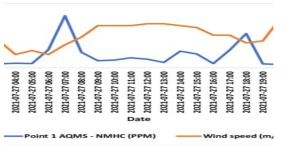
Exploring the Mineral-Rich Benefits of Acacia ehrenbergiana (Salam) from Fujairah: A Comparison with Common Staples for Nutritious Solutions in Arid Environments
In recent years, urban air quality has become a pressing concern worldwide due to the detrimental effects of non-methane hydrocarbons (NMHCs) on public health and the environment. NMHCs, which encompass a diverse range of volatile organic compounds, play a critical role in the formation of ground-level ozone and secondary organic aerosols. These pollutants are known to exacerbate respiratory issues and contribute to environmental degradation. Addressing this growing problem requires innovative approaches to monitoring and characterizing NMHCs in urban environments. Researchers at the Fujairah Research Centre (FRC) in collaboration with the Fujairah Environment Authority, have risen to this challenge by focusing on the characterization of NMHCs in urban areas using eNose sensor technology and their correlation with wind speed to identify emission sources. eNose systems mimic the human sense of smell using arrays of chemical gas sensors combined with pattern recognition software.These sensors can detect and quantify the presence of NMHCs in the air, providing minute-by-minute readings. Traditional monitoring methods often provide limited spatial and temporal resolution, making it difficult to pinpoint the origins of pollutants. However, eNose sensor technology offers a significant advantage in this regard. By analyzing the chemical fingerprints collected by the sensors, researchers can trace NMHCs back to their sources with high precision.These sensors have been strategically placed in locations prone to high emissions, such as industrial zones, traffic-heavy areas, and densely populated districts. This strategic placement ensures that the sensors capture data from the most significant sources of NMHCs, providing a detailed fingerprint of pollutant prevalence. The study utilized data from 86 fixed eNose sensors and several AQMS points spread across Fujairah. NMHC concentrations, wind direction, and wind speed data were collected hourly throughout 2021.The collected data were averaged and analyzed to determine the correlation between NMHC concentrations and wind parameters. To explore the correlation between NMHC levels and wind speed, the researchers at FRC have employed advanced statistical and computational techniques. The core of their approach involves integrating data from electronic nose (eNose) sensors with meteorological information.When combined with meteorological data such as wind speed and direction, these sensors offer a comprehensive view of how pollutants behave in the urban environment.This leads them to create comprehensive models of pollutant dispersion inorder to identify the conditions under which NMHC concentrations are highest and to determine how wind speed affects the transport of these compounds across urban areas.
The studies conducted by the Fujairah Research Centre(FRC) have revealed several key insights into the relationship between wind speed and NMHC concentrations. One of the most significant findings is the clear correlation between wind speed and pollutant levels. Generally, higher wind speeds lead to lower NMHC concentrations due to increased dispersion. However, the relationship is not linear, and certain wind conditions can lead to the accumulation of NMHCs in specific areas.In urban areas with heavy traffic, periods of low wind speed often result in elevated NMHC concentrations due to the limited dispersion of vehicular emissions. Conversely, high wind speeds can disperse these pollutants more effectively, reducing their concentration in the immediate vicinity but potentially transporting them to downwind areas. This understanding is crucial for developing targeted air quality management strategies that consider both local and regional impacts of NMHC emissions. The average NMHC concentration in 2021 was recorded at 0.424 ppm at point 1 AQMS and 0.256 ppm at point 2 AQMS. Higher concentrations were typically found when the wind blew from the southeast, indicating the direction of predominant emission sources. This study identified peak NMHC levels of 21.22 ppm when the wind was at 130 degrees. In conclusion,by providing detailed, real-time data on NMHC concentrations and their correlation with wind speed, this research offers valuable insights into the sources and dynamics of urban air pollution. The findings underscore the importance of continuous monitoring and the need for adaptive, targeted strategies to address the complex challenges of air quality in urban environments.As cities continue to grow and industrial activities expand, the integration of innovative technologies like eNose sensors will be crucial in ensuring sustainable and healthy urban living conditions. Rapid advancements in IoT and sensor technology, including electronic nose systems, have sparked renewed interest in air quality monitoring. Ref: Abdalla, R. Y. Y. A., Al Moalla, A., Ateeg, M., Kalathingal, M. S. H., & Ridouane, F. L. (2023). Characterization of Non-methane Hydrocarbons Fingerprint Prevalence in Urban Areas Using eNose Sensor Technology; Quantifying Correlation of Its Concentration with Windspeed for Identification of the Emission Sources. Read more at https://doi.org/10.20944/preprints202312.1481.v1
